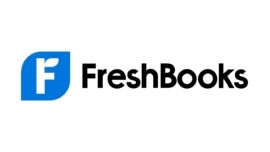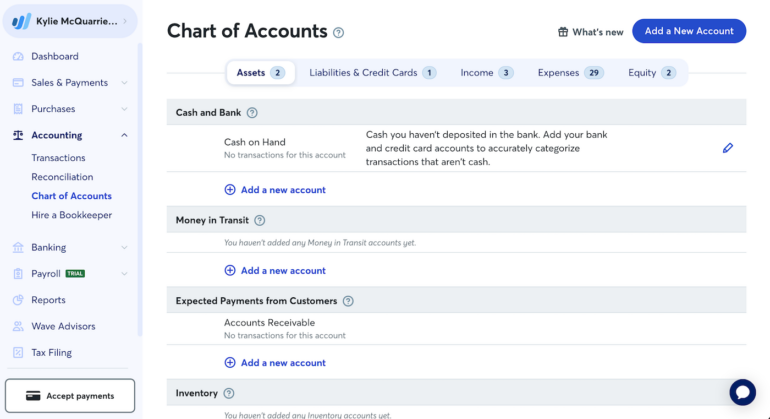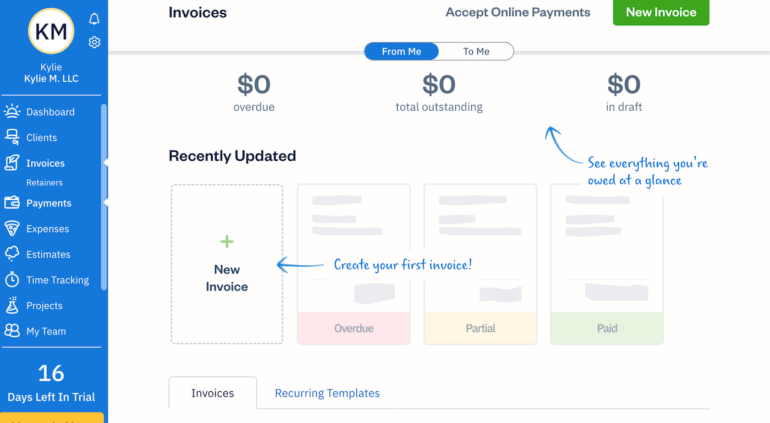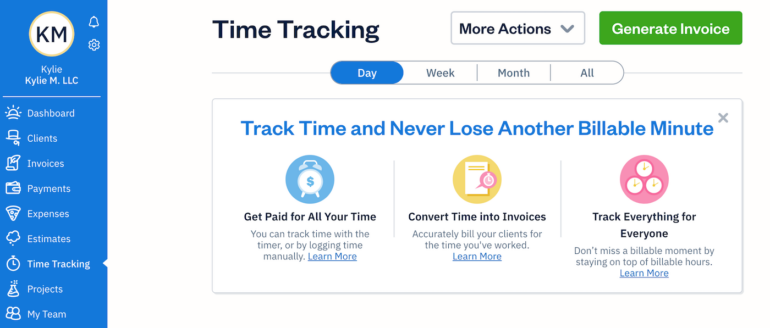
Wave and FreshBooks are two of the most noteworthy accounting software options for small businesses. Wave Accounting’s completely free software lets small-business owners — especially self-employed freelancers — track their finances, send invoices and get paid at no cost. FreshBooks, which starts at $17 a month, has more expansive invoicing features and multiple plans that scale up to support growing and midsize businesses.
However, FreshBooks can work well for some self-employed freelancers, and Wave Accounting’s features could be ideal for some small and midsize businesses. In our FreshBooks vs. Wave review below, we compare each software’s pros, cons, pricing and features to help you hone in on the right option for your needs.
Jump to:
Wave and FreshBooks handle the same basic bookkeeping tasks, from invoicing and billing to expense tracking and beyond. Although they were built for different types of business owners (Wave for freelancers, FreshBooks for other small businesses), both accounting tools go out of their way to cater to non-accountant business owners.
However, the two tools differ in terms of how much they cost, how many automations they offer and which third-party apps they sync with for crucial tasks like payroll and time tracking.
| Feature | FreshBooks | Wave Accounting |
|---|---|---|
| Starting price | $17 per month | Free forever |
| Time and project tracking | Yes | No |
| Inventory tracking | Limited | No |
| User limits | Unlimited (extra fee) | Unlimited |
| Payroll integration | Gusto, SurePayroll | Wave Payroll |
| Other third-party integrations | 100+ | Through Zapier only |
| Learn more |
Plan and pricing data verified as of 6/9/2023.
Rippling automatically syncs all your business’s HR data, like hours, leave and absence, with payroll. You never need to fill out spreadsheets and upload to another system— we pay your employees and HMRC directly.

Starting price: $17/mo. paid month-to-month or $183.60/yr. paid annually
FreshBooks’ four plans have fairly industry-standard pricing. Their features range from basic invoicing and accounting to enterprise-level financial reporting:
FreshBooks runs frequent sales throughout the year, offering new users discounts as deep as 60% or 70% off for up to six months. Businesses can also take advantage of a 10% discount if they pay annually rather than month to month.
Get more information on FreshBooks by reading our detailed FreshBooks review.
[Wave logo. Image: Wave Accounting]
Price: Free forever
Wave Accounting has just one plan and is completely free for life. You don’t have to enter any credit card information when you sign up for Wave, and you won’t pay anything to use the software itself.
The only charges you should expect while using Wave Accounting are standard transaction fees, which accompany all forms of online payment acceptance. In Wave’s case, those fees are as follows:
Transaction fees and data are accurate as of 6/9/2023.
Wave’s only paid software product is Wave Payroll, which starts at $20/month + $6/employee for self-service payroll or $40/month + $6/employee for full-service payroll.
Learn more about how Wave works by reading our comprehensive Wave Accounting review.
Winner: Wave Accounting
Both Wave and FreshBooks help you keep a close eye on your finances via income and expense tracking. Once you connect your business bank accounts and credit cards with your preferred software, Wave or FreshBooks automatically pull in transaction data to keep you up to date on your finances.
However, FreshBooks’ cheapest plan relies on the single-entry accounting system, which is less accurate than the more widely accepted double-entry system. And unlike nearly every other accounting competitor, FreshBooks doesn’t include free accountant access with its cheapest plan either.
By way of comparison, Wave Accounting, Xero, QuickBooks Online and most other accounting software services automatically default to double-entry accounting. All of these competitors include accountant access with every plan, even plans that otherwise limit you to one user only. (Figure A)
Figure A

Winner: FreshBooks
Both Wave and FreshBooks have excellent invoice templates that are easy to customize and send to clients. Both accounting products let you accept payments within the invoice, set up automatic recurring invoices and send payment deadline reminders.
However, FreshBooks has a few more invoicing features than Wave. For instance, with FreshBooks, you can attach expenses to your invoices for reimbursement, sync time-tracking data to each invoice, schedule automatic late payment charges and connect with your customers via FreshBooks’ client self-service portal. (Figure B)
Figure B

Wave Accounting wins big over FreshBooks in one key area: Truly unlimited invoicing. While FreshBooks lets you send an unlimited amount of invoices each month, it limits the number of clients you can send those invoices to.
| Plan name | FreshBooks Lite | FreshBooks Plus | FreshBooks Premium | FreshBooks Select |
|---|---|---|---|---|
| Billable clients per month | Up to 5 | Up to 50 | Unlimited | Unlimited |
Plan data accurate as of 6/9/2023.
Winner: Wave Accounting
Technically, both Wave Accounting and FreshBooks let you add unlimited users to your account. However, only Wave Accounting lets you do so for free.
Three of FreshBooks’ four plans include access for just one user in the base cost. (The enterprise-level accounting plan includes two users in the base cost.) While you can add as many users as you want, you’ll pay an extra monthly fee of $11 per person — a cost that can add up fast.
For instance, here’s how much you’ll pay for FreshBooks’ cheapest plan, FreshBooks Lite, with extra users.
| Base cost (FreshBooks Lite) | With 1 extra user | With 2 extra users | With 5 extra users | With 10 extra users |
|---|---|---|---|---|
| $17/mo. | $28/mo. | $39/mo. | $72/mo. | $127/mo. |
Plan and pricing data accurate as of 6/9/2023.
If you want multiple eyes on your accounts without paying extra, Xero has unlimited users. Zoho Books charges just $3 per month per extra user, and QuickBooks Online offers access for up to 25 users (depending on which plan you choose).
Winner: FreshBooks
Wave Accounting doesn’t have a built-in time-tracking tool, although you can use Zapier to integrate third-party apps like Timely with Wave. (Note that Wave Payroll doesn’t include built-in time tracking either.)
FreshBooks, in contrast, has an excellent time-tracking feature built into every plan. It’s easy to track time (for yourself or for any 1099 contractors you work with), then sync that time to your client’s invoice so you can be paid accurately for your time. (Figure C)
Figure C

Winner: FreshBooks
Wave Accounting’s only built-in integration is with its payroll product, Wave Payroll. And while Wave Payroll is perfectly serviceable, that’s about all it is. The software includes only basic payroll features like paycheck calculation, direct deposit, access to one payroll report and end-of-year W-2 form generation.
Additionally, Wave Payroll’s full-service plan, which calculates and remits payroll taxes on your behalf, is limited to 14 states. Clients in all other states must use Wave Payroll’s self-service plan, which costs less but requires you to file payroll taxes on your own.
In contrast, FreshBooks syncs with Gusto and SurePayroll, two of the most fully featured payroll solutions for small businesses in the U.S. (FreshBooks also has built-in payroll integrations for its software users in Canada, the U.K. and Australia.) Gusto is a full-service payroll provider only while SurePayroll has both a self-service and full-service plan.
Unlike Wave Payroll, Gusto and SurePayroll can help you find healthcare and other benefits for your employees (though with Gusto, health insurance is available in only 37 states and D.C.). Both providers also have more HR tools than Wave, including new-hire reporting and basic onboarding features.
Winner: FreshBooks
Since Wave Accounting is a free tool, it doesn’t have robust customer support. Users can always access Wave’s resource library online or contact the customer service team via email, but Wave lacks any phone- or chat-based support. (The same thing is true for Wave Payroll as well: Customer service is email-only.)
FreshBooks has a robust online resource library and a basic troubleshooting chatbot. Most importantly, it also has email and phone support. You can request help directly from your FreshBooks dashboard, which includes quick links to the FreshBooks help center.
To compare Wave Accounting vs. FreshBooks, we created free accounts with both services so we could test each tool’s user-friendliness, features, and mobile apps. We viewed demos and product specs on both competitors’ sites. We also considered opinions from verified users on third-party sites (the BBB, the App Store and Google Play, among others) to draw conclusions about overall customer satisfaction, customer service responsiveness and more.
To guide our research, we focused specifically on how each software solution excelled or fell short in the following areas:
While you should always take your business’s unique needs into account when choosing an accounting software provider, we recommend following these general guidelines.
If you don’t think either Wave or FreshBooks will work for you, there are dozens more accounting software options to choose from, starting with these:
Finally, even if you’re pretty sure you’ve found the right accounting product for your business, we recommend taking it out for a test-drive first. All the products on this list are free (like Wave Accounting), offer a free plan (Zoho Books) or include a 30-day free trial (QuickBooks, Xero and FreshBooks).
Setting up a free account is the ideal first step toward finding accounting software that will help you meet — and even exceed — your financial goals.
Read next: Vendor comparison: Small business financial accounting software
Rippling automatically syncs all your business’s HR data, like hours, leave and absence, with payroll. You never need to fill out spreadsheets and upload to another system— we pay your employees and HMRC directly.